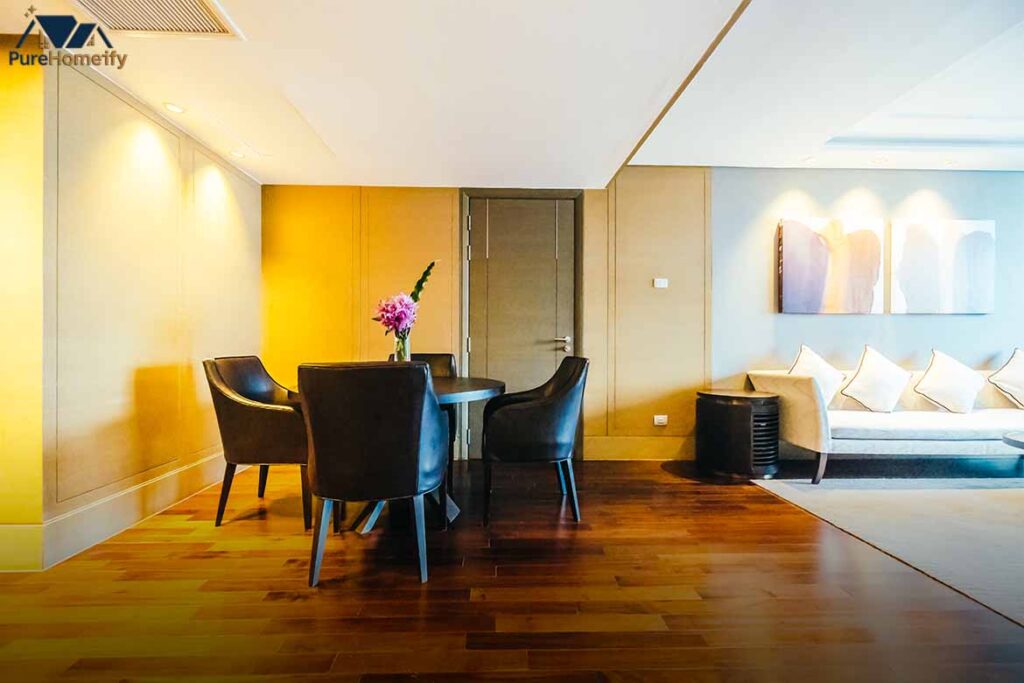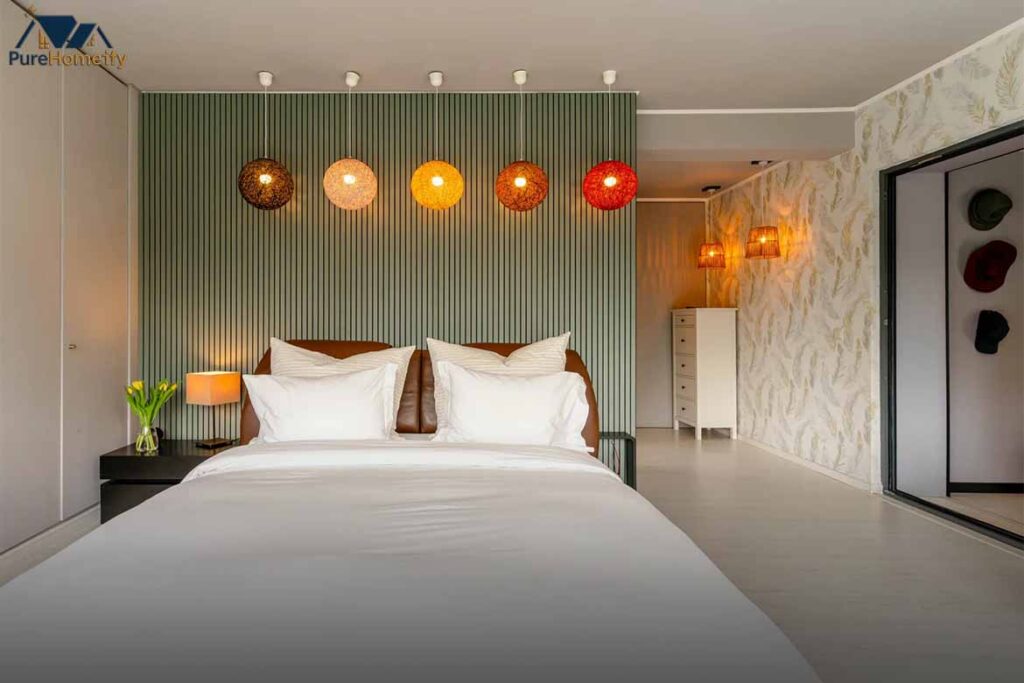When you live in a home with high ceilings, the spacious and open design feels beautiful, but it often comes with an unwanted issue: echo and reverberation. The extra height creates room for sound to travel longer, making conversations, music, or even television sound harsh and distracting. The problem is worse in tall rooms / vaulted ceilings with hard floors, bare walls, or minimal furniture, because sound waves bouncing off ceiling and walls have nothing to absorb them. Learning how to reduce echo in a room with high ceilings is the key to enjoying comfort, clarity, and peace in your living space without losing the elegance of your architecture.
What Causes Echo in Rooms with High Ceilings?

Echo happens when sound waves bouncing off ceiling and walls reflect multiple times before fading. In tall rooms or vaulted ceilings, these reflections have more distance to travel, which makes the sound louder and more noticeable. Smooth hard surfaces, like concrete, wood, and glass, act like mirrors for sound.
Homes with open layouts and little furniture allow these waves to move freely. Without materials to absorb sound, the energy keeps traveling. This explains why modern living rooms with minimal décor face louder echoes compared to older houses packed with upholstered furniture for tall rooms and thick rugs.
Why Echo Is More Noticeable in Large or Open Spaces
Echo reduction for open-plan rooms can feel difficult because of their size. Large spaces have more reflective surfaces and fewer barriers to break sound waves. That’s why a tall ceiling living room often feels noisier than a smaller bedroom.
The difference between echo and reverberation matters too. Echo is a distinct repetition of sound, while reverberation is the lingering effect of waves colliding in the space. Both are more common when you combine high ceilings with minimal furniture.
Easy Ways to Reduce Echo with Soft Furnishings

One of the best ways to stop echo in high ceiling spaces is adding softness. Sound absorbs better in cushions, throws, and fabric furniture compared to hard surfaces. The more you layer soft items, the less energy sound waves bouncing off ceiling and walls will have.
For instance, homes with large couches, ottomans, and padded chairs feel quieter than those with just wood or leather. Adding upholstered furniture for tall rooms also doubles as a design choice while cutting down on excess noise.
Using Curtains, Drapes, and Wall Hangings to Absorb Sound
Windows and bare walls amplify sound. Installing heavy drapes and curtains is an effective way to soften reflections. Acoustic drapes are designed for this, but even thick fabric curtains provide decent results for a reduce echo in high ceiling room project.
Wall hangings also work as absorbers. Tapestries, quilts, or fabric acoustic panels reduce sharp reflections. These additions are both practical and stylish, especially when paired with decorative sound-absorbing ideas for high ceilings like acoustic art panels.
Ceiling Solutions to Minimize Echo (Acoustic Panels, Tiles, and Clouds)
Since the ceiling is often the biggest reflective surface, acoustic solutions for high ceilings are essential. Installing ceiling acoustic panels for tall rooms makes a dramatic difference by absorbing sound right where it travels most.
Suspended hanging acoustic clouds or baffles not only absorb sound but also add an artistic touch. They are widely used in conference rooms, theaters, and churches, but they can also transform a noisy home living room into a calm retreat.
Flooring Fixes: Rugs, Carpets, and Sound-Absorbing Materials
Bare floors reflect sound strongly. Adding carpets and large area rugs can soften those reflections. Large rugs, especially with thick padding, cut down on echo in tall rooms by absorbing the low to mid-range frequencies.
In the USA, homeowners often combine hardwood flooring with decorative rugs. This balance keeps the elegant look of wood while adding practical sound absorption. Using rugs and curtains for high ceiling echo is one of the easiest starting points.
Furniture Placement and Room Layout for Better Acoustics
Strategic furniture placement for echo control changes how sound moves in a room. Large sofas, bookshelves, and dining tables act as natural barriers that scatter sound. Placing these pieces carefully helps break up long pathways where sound would otherwise travel freely.
An optimized room layout for echo reduction doesn’t require expensive changes. Even moving a couch away from the wall or adding a divider in an open-plan living room can reduce harsh echoes significantly.
Decorative Ideas That Double as Sound Absorbers (Bookshelves, Plants, Art)
Bookcases and wall décor for sound absorption are powerful tools. Filled shelves act like sound diffusers, scattering waves instead of letting them bounce directly. Mixing different sizes of books and objects gives even better results.
Adding plants as natural sound absorbers can help too. Large leafy plants absorb sound while adding greenery. Likewise, decorative sound-absorbing ideas for high ceilings include hanging fabric art or acoustic paintings that look stylish while reducing noise.
Advanced Acoustic Treatments for High Ceilings
Sometimes DIY isn’t enough. That’s when acoustic ceiling treatments come in. Professional solutions like fabric acoustic panels, ceiling sound diffusers, and bass traps target specific sound frequencies. These are used in home theaters, studios, and worship spaces where quality sound is critical.
The most effective advanced option is combining multiple techniques. Pairing ceiling acoustic panels for tall rooms with hanging acoustic clouds or baffles ensures both style and performance. This is especially effective in soundproofing ideas for vaulted ceilings.
When to Call a Professional for Echo Reduction

Not every problem can be solved with rugs or curtains. If your space still feels uncomfortably loud, it’s time to consult an expert. Professionals test the acoustics of tall rooms or vaulted ceilings and recommend tailored treatments.
While professional services may cost more, they bring long-term benefits. For example, one case study from a home in Texas showed how combining acoustic ceiling treatments and wall panels cut noise levels by nearly 60%, making the family’s tall ceiling living room cozy and quiet.
Table: Quick Comparison of Echo Reduction Methods
| Method | Best For | Effectiveness | Cost Range |
| Rugs and Carpets | Floors in large rooms | Medium | Low |
| Heavy Drapes and Wall Hangings | Windows and walls | Medium-High | Low-Medium |
| Acoustic Ceiling Panels & Clouds | High ceilings and big rooms | High | Medium-High |
| Bookshelves & Plants | Decorative sound-absorbing ideas for high ceilings | Medium | Low |
| Professional Acoustic Treatment | Complex echo problems | Very High | High |
Conclusion
Echo problems in high ceilings don’t have to ruin your living space. Whether you add rugs and curtains for high ceiling echo, install acoustic ceiling treatments, or bring in professionals, every step helps. By exploring both simple fixes and advanced solutions, you’ll know exactly how to reduce echo in a room with high ceilings and enjoy a quieter, more comfortable home.
FAQs
How do I make my room less echoey?
You can make your room less echoey by adding carpets, curtains, upholstered furniture, and acoustic panels that absorb sound.
Are high ceilings bad for acoustics?
Yes, high ceilings often create poor acoustics because sound waves travel farther and bounce more, causing echo and reverberation.
How to circulate air with high ceilings?
Use ceiling fans, floor fans, or HVAC systems with return vents to circulate air effectively in tall rooms / vaulted ceilings.
How to absorb sound in a large room?
Add rugs, heavy drapes, fabric wall hangings, and bookcases to absorb sound in a large room and reduce echo.
How to soundproof high ceilings?
Install acoustic ceiling treatments like panels, tiles, or hanging acoustic clouds to reduce noise and control reverberation.

